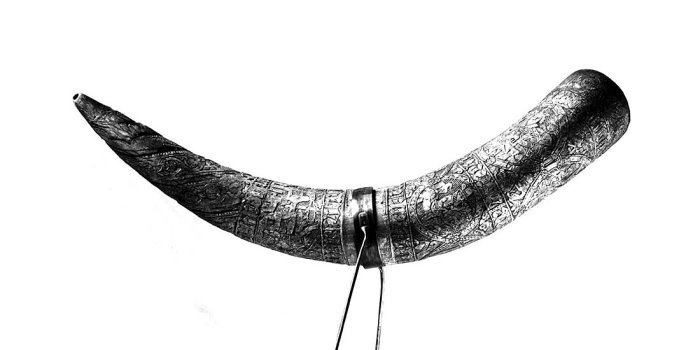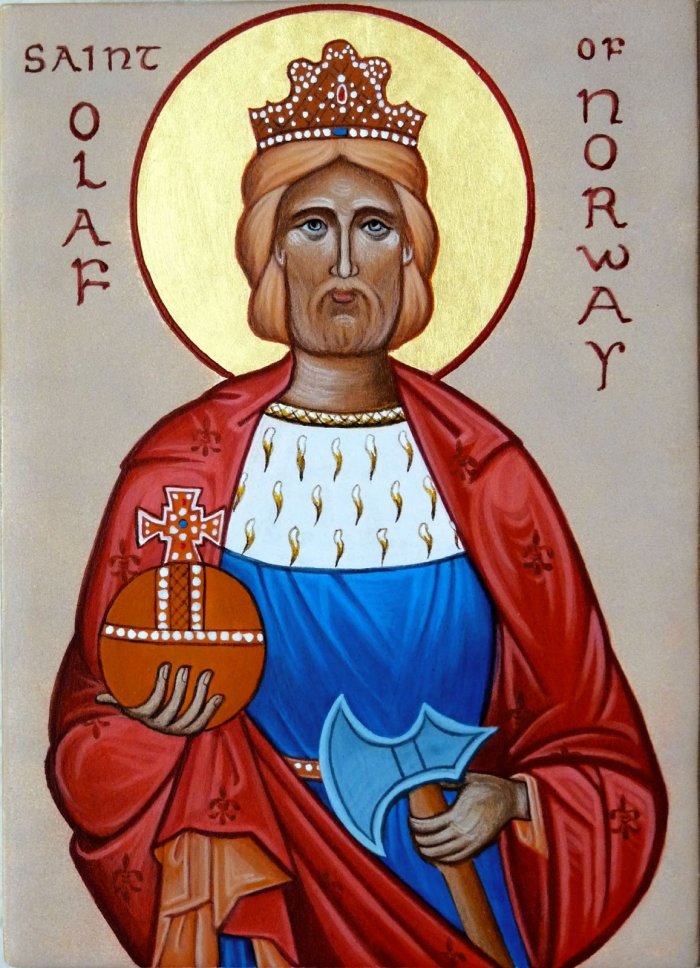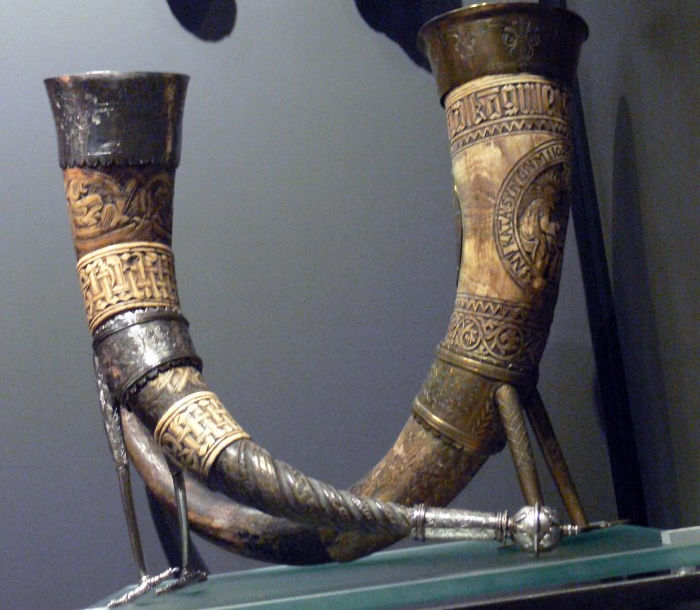Ancient Icelandic Drinking Horn Reveals An Interesting Story About Saint-King Olaf
Ellen Lloyd - Ancient Pages.com - Drinking horns were popular among many different ancient cultures. They were used by Scandinavians, Greeks, Romans, Thracians, Scythians, and people in Africa. People have been drinking from horns for at least 2,600 years.
Drinking horns were status symbols and widely used as gifts, both in the Middle Ages and in the centuries after the Reformation. The picture shows one of the few drinking horns that have remained in Icelandic possession, called the "Three kings horn." It shows Saint Olav juxtaposed with Old Testament kings Solomon and David. Photo: National Museum of Iceland
During the Middle Ages, drinking horns were considered precious objects with great symbolic value. Drinking horns had names and were a symbol of status. Medieval people believed the horns came from the foot or claw of the mythical griffin, a legendary creature portrayed as a mix between an eagle and a lion.
Due to their value, many drinking horns were stolen and ended up in princely cabinets.
"Mediaeval drinking horns are scattered in collections throughout northern Europe. They were coveted collectibles. Medieval art often remained in churches until it went out of fashion or was removed due to errors in iconography, whereas drinking horns ended up in princely collections and cabinets and have kept their status to the present day," says Associate Professor Margrethe Stang, from the Norwegian University of Science and Technology's (NTNU) Department of Art and Media Studies.
St.Olaf – Patron Of Norway
Olaf II Haraldsson (995 – 29 July 1030) was a King of Norway from 1015 to 1028.
He was a martyr and became later declared a saint king who wanted to free Norway from the domination of the Danes and the Swedes.
In 1019, St.Olaf defeated Earl Sweyn at Nesje and requested that missionaries be sent from England to advance the Christianization of Norway. Owing to the harsh nature of his rule, he faced a rebellion of nobles in 1029. Through the aid of the formidable King Canute of Denmark, the rebels overthrew him and drove him into exile in Russia.
St. Olaf returned to Norway, but he was slain in battle at Stiklestad, on July 29 in 1031.
During his lifetime, St.Olaf was not very popular and was not considered especially holy. However, St. Olaf was revered after death owing to reports of miracles occurring at his tomb. He was greatly respected as a champion of Norwegian independence, and his shrine became the foundation of the cathedral of Trondheim, a popular pilgrimage place during the Middle Ages. He is the patron of Norway and was canonized in 1164.
Depictions Of St.Olaf On Icelandic Drinking Horns
Stang, an art historian, studied how St. Olav has been depicted on Icelandic drinking horns.
The Reformation in the 1500s brought an end to the worship of Catholic saints, and St. Olav was no longer to be considered a saint. The motifs on the Icelandic drinking horns show that the saint-king acquired a new role.
St. Olav is portrayed on the drinking horns "alongside biblical ideal kings like King Solomon and King David and historical figures like Charlemagne and Constantine, the first Christian emperor of the Roman Empire. It's clear that the old Catholic saint is being depicted in a new context as a historical king and not a saint-king. He was given a new role. The horns show a shift in the perception of Olav," Stang says.
Even after the Reformation, Stang suspects that Olav was considered a saint.
"When Christian IV traveled to Norway in 1599, we know that a toast to St. Olav was raised during a peasant wedding. The fact that a culture existed to toast the saints gives great context for the drinking horns. The horn motifs reflect their use and show their close relationship," she says.
Norwegian drinking horns are smooth and have inscribed metal mountings, while Icelandic ones consist only of the horn. However, they are richly decorated with reliefs carved into the horn itself.
Two Icelandic drinking horns from around 1600 in the Danish National Museum. Credit: Christian Bickel - CC BY-SA 2.0 de
Why St. Olav is depicted on so many Icelandic drinking horns is one of the questions that researchers have not yet answered
Stang believes St. Olav must have had a different status in Iceland than in Norway and that the importance of his being a Norwegian king must have been experienced differently.
"St. Olav was a popular saint across much of northern Europe, but I think there was a wide variation in how he was perceived. We might not have recognized the Olav that was worshipped in northern Germany, for example. The cult of saints had a stronger local stamp than we normally imagine," she says.
Stang relates a story from one of the Icelandic bishops' sagas, where Icelanders and Norwegians find themselves on a boat to Norway, discussing the saints.
The Norwegians tell the Icelanders that their saints are too weak and are "punished" for their harassment of the Icelanders. This saga "shows that the cult of the saints had many local and regional variants and that they were important for local identity," says Stang.
Written by - Ellen Lloyd – AncientPages.com
Copyright © AncientPages.com All rights reserved. This material may not be published, broadcast, rewritten or redistributed in whole or part without the express written permission of AncientPages.com
Expand for referencesMore From Ancient Pages
-
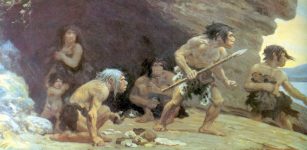 Scientists Found A Link Between Ancient Human Teeth And An Extinct Reptile
Archaeology | Jan 10, 2022
Scientists Found A Link Between Ancient Human Teeth And An Extinct Reptile
Archaeology | Jan 10, 2022 -
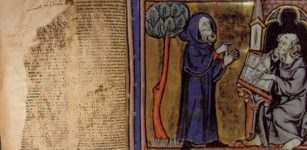 One Of The Oldest Manuscripts Fragments Of The Famous Merlin Legend Discovered
Archaeology | Sep 2, 2021
One Of The Oldest Manuscripts Fragments Of The Famous Merlin Legend Discovered
Archaeology | Sep 2, 2021 -
 On This Day In History: Battle Of King’s Mountain Was Fought – On Oct 7, 1780
News | Oct 7, 2016
On This Day In History: Battle Of King’s Mountain Was Fought – On Oct 7, 1780
News | Oct 7, 2016 -
 Skeletal Remains Of A 1,500-Year-Old Byzantine Ascetic Monk, Chained In Iron Rings – Uncovered Near Jerusalem
Archaeology | Jan 4, 2023
Skeletal Remains Of A 1,500-Year-Old Byzantine Ascetic Monk, Chained In Iron Rings – Uncovered Near Jerusalem
Archaeology | Jan 4, 2023 -
 Long-Standing Mystery Of What May Have Triggered Ice Age Solved – New Study
Archaeology | Jun 24, 2022
Long-Standing Mystery Of What May Have Triggered Ice Age Solved – New Study
Archaeology | Jun 24, 2022 -
 Burnt Mound Complex Dated To Bronze Age – Uncovered At Suffolk Site
Archaeology | Jun 19, 2023
Burnt Mound Complex Dated To Bronze Age – Uncovered At Suffolk Site
Archaeology | Jun 19, 2023 -
 Zagros Mountains: Home To Tribes, Kingdoms And Empires For Thousands Of Years
Civilizations | Sep 16, 2020
Zagros Mountains: Home To Tribes, Kingdoms And Empires For Thousands Of Years
Civilizations | Sep 16, 2020 -
 World’s Largest Complex Of Borobudur – Spectacular Buddhist Masterpiece
Civilizations | May 3, 2016
World’s Largest Complex Of Borobudur – Spectacular Buddhist Masterpiece
Civilizations | May 3, 2016 -
 Unraveling The Mystery Of The Phoenix Bird – Symbol Of The Sun And Eternal Rebirth Of Life
Egyptian Mythology | Nov 6, 2023
Unraveling The Mystery Of The Phoenix Bird – Symbol Of The Sun And Eternal Rebirth Of Life
Egyptian Mythology | Nov 6, 2023 -
 Mysterious Ancient Tomb Reveals ‘Impossible’ Cosmic Connection – Wrong Identity – Part 1
Ancient Mysteries | Oct 11, 2020
Mysterious Ancient Tomb Reveals ‘Impossible’ Cosmic Connection – Wrong Identity – Part 1
Ancient Mysteries | Oct 11, 2020 -
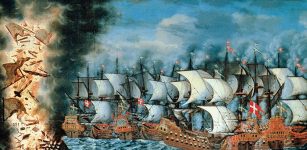 On This Day In History: Dramatic Battle Of Öland – On June 1, 1676
News | Jun 1, 2016
On This Day In History: Dramatic Battle Of Öland – On June 1, 1676
News | Jun 1, 2016 -
 2,ooo-Year-Old Ancient Roman Treasure Found Underwater Of The Coast Of Portofino, Italy
Archaeology | Jan 31, 2019
2,ooo-Year-Old Ancient Roman Treasure Found Underwater Of The Coast Of Portofino, Italy
Archaeology | Jan 31, 2019 -
 Unusual Secret May Be Hidden In A Mysterious Valley In The American Southwest
Featured Stories | Jan 30, 2024
Unusual Secret May Be Hidden In A Mysterious Valley In The American Southwest
Featured Stories | Jan 30, 2024 -
 First Leaf Fossils Study Reveals An Ancient 4 Million-Year-Old Forest In Borneo
Fossils | May 3, 2022
First Leaf Fossils Study Reveals An Ancient 4 Million-Year-Old Forest In Borneo
Fossils | May 3, 2022 -
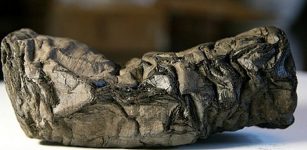 2,000-Year-Old Herculaneum Scrolls Will Be Unwrapped And Deciphered
Archaeology | Oct 8, 2019
2,000-Year-Old Herculaneum Scrolls Will Be Unwrapped And Deciphered
Archaeology | Oct 8, 2019 -
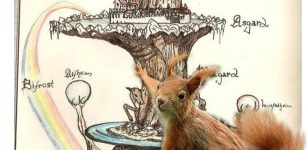 Ratatoskr- Inhabitant Of Yggdrasil That Loves Intrigue, Strife And Gossips In Norse Beliefs
Featured Stories | May 28, 2020
Ratatoskr- Inhabitant Of Yggdrasil That Loves Intrigue, Strife And Gossips In Norse Beliefs
Featured Stories | May 28, 2020 -
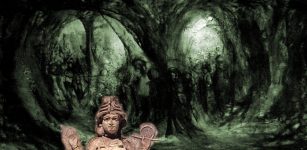 Death And Afterlife In Sumerian Beliefs
Civilizations | May 12, 2017
Death And Afterlife In Sumerian Beliefs
Civilizations | May 12, 2017 -
 Anansi The Spider: Trickster And Spirit Of Knowledge In African Mythology
African Mythology | Jul 20, 2016
Anansi The Spider: Trickster And Spirit Of Knowledge In African Mythology
African Mythology | Jul 20, 2016 -
 Gigantic Ancient Palace Unearthed In Mexico’s Valley Of Oaxaca
Archaeology | Mar 29, 2017
Gigantic Ancient Palace Unearthed In Mexico’s Valley Of Oaxaca
Archaeology | Mar 29, 2017 -
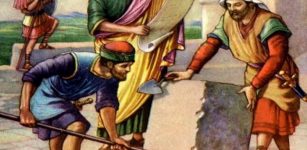 Biblical Events Confirmed: The Jerusalem’s Wall That Nehemiah Built
Biblical Mysteries | Mar 19, 2014
Biblical Events Confirmed: The Jerusalem’s Wall That Nehemiah Built
Biblical Mysteries | Mar 19, 2014

